The Economics and Statistics Division maintains archives of previous publications for accountability purposes, but makes no updates to keep these documents current with the latest data revisions from Statistics Canada. As a result, information in older documents may not be accurate. Please exercise caution when referring to older documents. For the latest information and historical data, please contact the individual listed to the right.
<--- Return to Archive
For additional information relating to this article, please contact:
August 17, 2022CENSUS LANGUAGES, 2021 Today's release of 2021 Census results reports on languages in Canada, including languages used in the home, mother tongue and knowledge of official languages.
In Nova Scotia, 93.4% of respondents reported that English (only) was the language they spoke most often at home. This was the second highest share of those who reported English as the (only) language most often spoken at home, after Newfoundland and Labrador. Across Canada, 63.8% report that English (only) is the language most often spoken at home.
French (only) was most often spoken at home by 1.3% of Nova Scotians. Across Canada, 19.2% of the population spoke French (only) most often at home; this was notably concentrated in Quebec (77.5% French-only) and New Brunswick (26.4% French-only).
In Nova Scotia, 3.8% of respondents spoke a non-official language most often at home. Across Canada, 12.7% of respondents spoke a non-official language most often at home with notably higher shares in British Columbia, Ontario, Alberta and Manitoba.
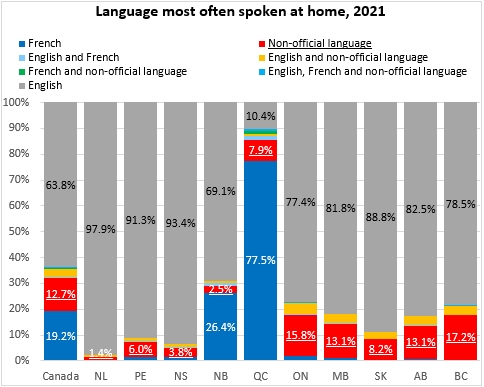
Although Nova Scotia had a relatively small number of respondents who mostly spoke a non-official language at home, this number increased by 61.0% between the 2016 and 2021 Censuses. Across Canada, the number speaking a non-official language primarily at home increased by 16.7% - including a near-doubling of this number in Prince Edward Island.
In Nova Scotia, the number speaking mostly French (only) in the home declined by 12.3%. The number of respondents speaking French (only) at home increased by 1.5% across Canada - entirely accounted for by increases in Quebec and British Columbia.
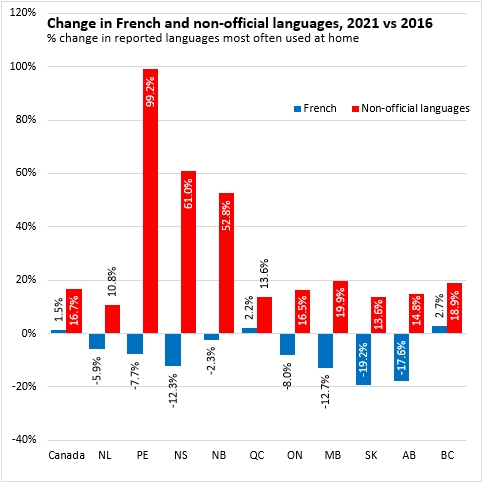
The 2021 Census results reported on minority official language use - stated as the potential demand for services in a minority official language. This refers to those speaking English (either as mother tongue or language used primarily in the home) in Québec and those speaking French elsewhere.
In Nova Scotia, there is a potential demand for 4.6% of services to be delivered in French. New Brunswick had the highest portion of potential minority language demand at 33.5%. Demand for minority language services in Québec was 20.2% (referring to English). Newfoundland and Labrador reported the lowest potential demand for minority language services.
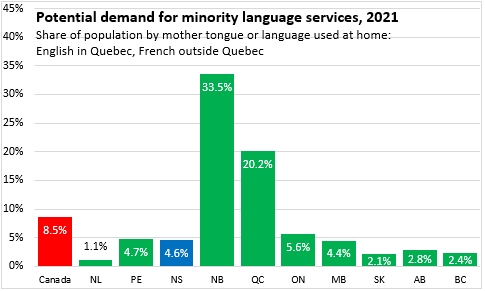
Among Nova Scotia's counties, the potential demand for French language services was notably higher in Yarmouth, Digby, Inverness and Richmond counties. Potential minority language service demand was lowest in Victoria, Cape Breton, Pictou and Annapolis counties.
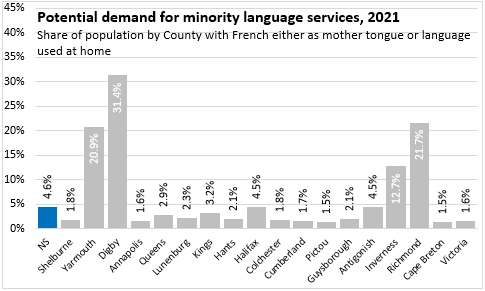
The 2021 Census language results provide details beyond Canada's official languages of English and French. This reports languages spoken in the home and includes those who report multiple responses.
Across Nova Scotia, 930,385 respondents spoke English in the home while 28,635 spoke French in the home. Beyond Canada's official languages, the next most widely spoken languages in Nova Scotia were Arabic, Mandarin, Hindi, Punjabi and Mi'kmaq.
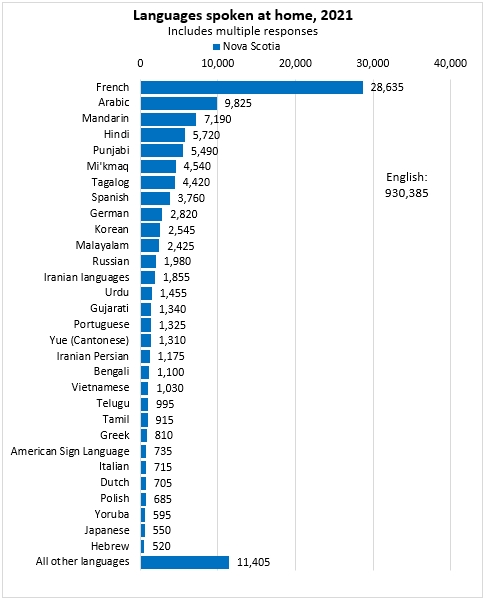
In Halifax, English and French were the most widely spoken languages at home, followed by Arabic, Mandarin, Hindi, Punjabi and Tagalog. Mi'kmaq was not reported as a widely-spoken language in Halifax.

In the Cape Breton regional municipality, Mi'kmaq was the second most widely spoken language at home after English.

In Kentville and New Glasgow, French and Tagalog were the most commonly spoken languages at home outside of English.
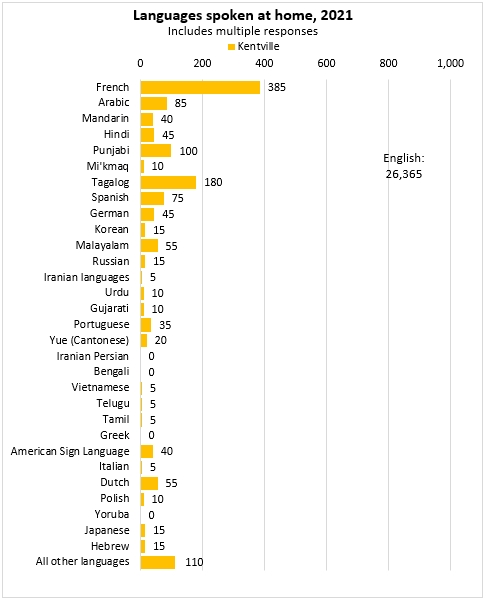
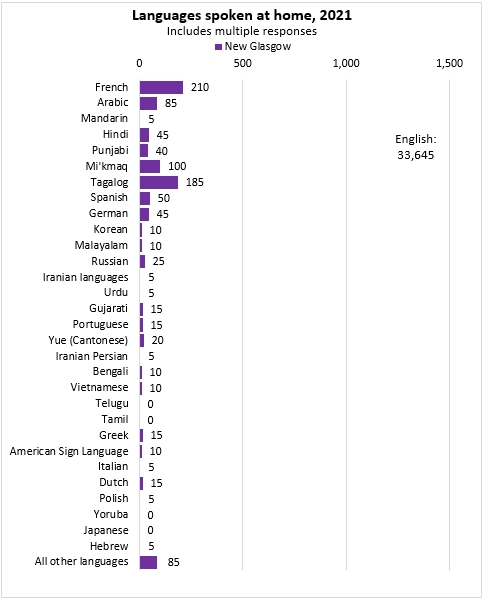
In Truro, French and Punjabi were the two most widely spoken languages in the home other than English.
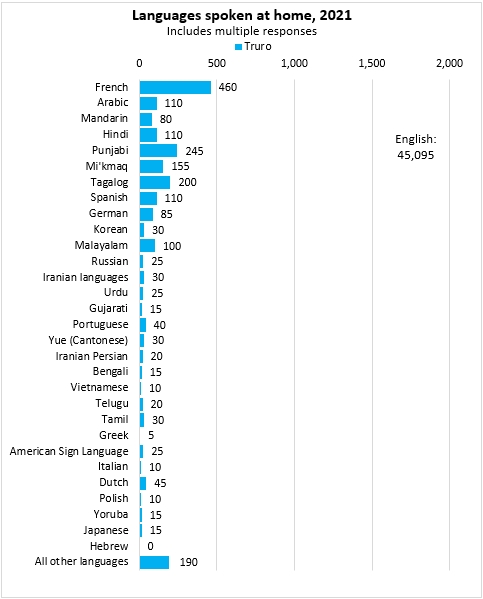
Outside of Halifax, Cape Breton RM, Kentville, Truro and New Glasgow, the most widely spoken non-English languages were French, German and Mi'kmaq.
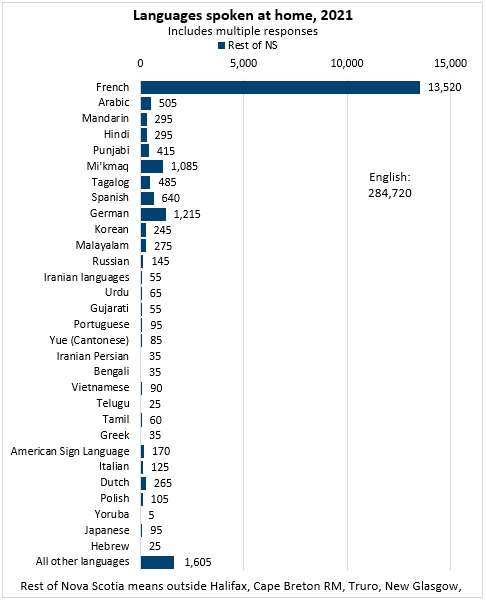
Source: Statistics Canada. Table 98-10-0226-01 Language spoken most often at home by age: Canada, provinces and territories; Table 98-10-0215-01 Potential demand for federal communications and services in the minority official language: Canada, provinces and territories, census divisions and census subdivisions; Table 98-10-0201-01 Language spoken at home by single and multiple responses of language spoken at home and mother tongue: Canada, provinces and territories, census metropolitan areas and census agglomerations with parts
<--- Return to Archive